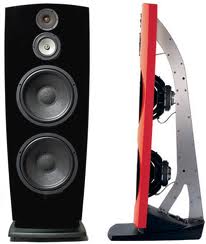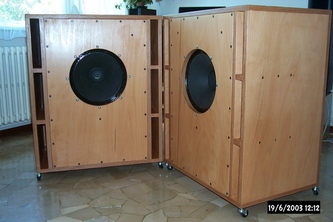|
Today, I thought I would recap the main principles I abide to when I design speakers and credit the people and companies that have inspired me in setting up these goals. 1/. Full Range I believe this is the ultimate goal, although one which is more like a dream rather than a potential reality. A number of DIYers have a lifetime commitment to achieve that, but if we are realistic, then I would suggest we aim for a full range driver with a good accurary from 100Hz to 5 to 10 KHz, and complement this with one extra driver on each end of the spectrum. The driver that triggered that quest for me was the Supravox RTF215, of Elipson fame. One of the benefit of going full range is the phase and timbre accuracy. I would credit Renaud de Vergnette of Triangle fame with whom I share many a HiFi show, and who became a friend over time. I do differ from him though, in the way that I prefer to use a minimum number of drivers, where his designs are usually using a multitude of drivers. He has the advantage of making his own drivers, so does Jacques Mahul, originally helped by inheriting a lot of machinery from his father's business. Full range drivers tend to be also high efficiency, which is my second criteria. 2/. High Efficiency High efficiency is a key to low distortion, as both the drivers and the amplifier are used within their confort zone. another benefit is the transient response that tends to improve with the efficiency, mainly because one way to do it is by reducing the mass of the driver's moving parts. I would credit Jean Hiraga and the Audiophile team, as well as La Maison du Haut-Parleur, both advocates of the Fostex range, low power Class A amplifiers and breautiful timber horns. 3/. Paper membranes Yes, I know, it sounds old fashioned, but to my ears, specially in the midrange, there is no better material. The only other material I tried and liked is metal, and namely the full range Jordan drivers. On the bass side, I have tried carbon fiber, kevlar and a Cabasse driver with a plastic foam membrane, which sounds better than paper but so much more expensive (at the time about four times the price of a SEAS or VIFA...). For the treble, I am quite keen on metals like aluminium in the TW8 from Audax, again of Elipson fame, and now titanium and beryllium, Focal being the master here and diamond which is neither metal, or else, a class of its own and only used by B&W at this stage, as far as I know. All these new technologies are quite expensive and most beyond the reach of the HiFi enthusiast. Another metal tweeter is of the ribbon variety. Although I have not used it yet, I have had a chance to listen to many and quite like what I heard and will try to use one in my next project. Then, there is the electrostatic speaker of Quad and Martin Logan fame. And in a word, I would LOVE to have a pair of Martin Logan, so if there is generous person out there... 4/. Small cabinet(s) Cabinet vibrations are a disease and can muddle the sound quite signicantly. The bigger the cabinet, the more difficult it is to prevent it to vibrate, but the lower the bass extension can be...so, it is a little bit like the quadrature of the circle, isn't it? Solutions? Small footprint, tall cabinets, several cabinets for each band of the spectrum, up to the (probable...) overkill of the Utopia by Focal, are good design principles. Again, I quite like the B&W Nautilus or their more recent 800 series. Many a trick have been invented to lower cabinet vibration and resonances. Again, Joseph Leon's resonators and the Matrix from B&W were revolutionary concepts. I believe that after the recent final demise of Elipson, the resonator patent is now in the public domain, and I would be keen to implement it in my current design or on my next project. Another idea is to get rid of the cabinet all together as in the open baffle variety. Successfull commercial design is definitely by JAMO (and it looks SO good...) I also recommend visiting www.decware.com for more inspiration. In the 80s, AW Audio designed an electrodynamic panel on these principles that worked extremely well, and he did the best demos ever. If anybody has a picture of the EA-11, or still owns a pair, I would appreciate a photo and/or a review... 5/. Time Alignment Music is all about transients and the only way to reproduce them properly is to have phase accuracy across the full range of the speaker. The more drivers, the more difficult it is to achieve. One simple way is to do it by way of aligning the voice coils, which then conducts usually to complex cabinets geometries. Again, examples are with the Elipson sphere, but still in favor with current designers like B&W, Wilson Audio, and on the French side Jean-Marie Raynaud that I didn't get to mention so far. He is certainly one of the most long lasting French speaker designers around having started in 1967 and still at it. His latest implementation of "mechanical" time alignment being his Concorde Signature. Another way to do it is by designing the filter appropriately. Again Jean-Marie Raynaut has implemented this idea in his Offrande Supreme. Most designs are using this approach more or less successfully. Last but not least, modern technology and digital filtering and time delay together with multiamplification can conduct to spectacular design for a reasonable price. Examples are the Emerald Physics open baffle design, and again our Frenchies are not far behind with a DIYer using the DCX2496 from Beringher, but taking it to another level by completely redesigning its weaker parts: www.dcx2496.fr I am quite tempted to try that out in one of my next project! 6/ Closed box or else??? Well, I have already mentioned my interest for the open bafle. Having said that, I believe my ultimate goal would be to design a SMALL transmission line speaker. My first attempt was not very successful, I have to admit, as I found out recently, the driver I was using was not at all suitable for this purpose. I think if you are going to use a sealed enclosure, then you should consider internal resonator(s) to improve the results. Most speakers nowadays are using some form of vented enclosure as this is the most efficient and simple way to extent the bass response of any driver. So, here I do not have a firm principle and I am only guided by the brief and the drivers I use (or intent to use) 7/. Form follows Function This is very important to me, as I believe a well designed loudspeaker should also look good and be an addition to your furniture and not an intrusion in your space. And yes, it has something to do with the W.A.F. factor ( wife acceptance factor - if your are not familiar with this acronym, yet, then you should!) I invite you to nominate your most WAF friendly designs and your most unfriendly ones. That should make for an interesting discussion... I will enhance this post with more links and photos over the coming days. I mentioned before that at about the same time I built my first HiFi system, I got exposed to the Elipson 4040s and that changed my (audio) life!
I could not afford a pair of these fabuloous speakers and had no room for them anyway, but I could afford to buy a pair of 215 RTF from Supravox and the plywood to build new speakers. I built the RJ baffle at the time. I helped a friend build an Onken version with a Fostex compression tweeter on top in the late 80s Both fabulous full sound, courtesy of the perfect phase across the frequency range, the high efficiency and full range of the speakers. Difficult to beat, specially if driven by a low power valve amp! |
AuthorBorn in France, well travelled, relocated to Sydney in 1997. Archives
July 2023
Categories
All
|







 RSS Feed
RSS Feed
